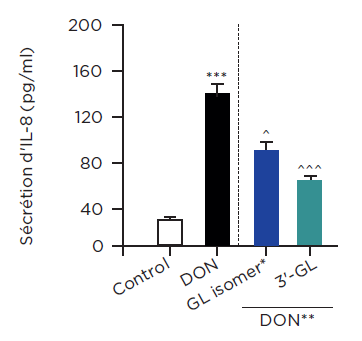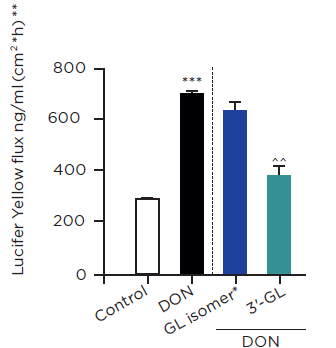3′-galactosyllactose (or 3′-GL) is a human milk oligosaccharide, with an anti-inflammatory effect that reduces the immune responses of the immature gut1.2. This HMO* is proving to be an essential ally in the positive modulation of the immune system through the infant gut microbiota.
3′-GL STUDIES
3′-galactosyllactose is a human milk oligosaccharide, made up of two galactoses and one glucose. It is found in colostrum in large quantities and then in mature milk in lower quantities3. It has a direct anti-inflammatory effect on immune cells, protects the integrity of the gut barrier and supports the modulation of the infant’s innate immune system4.
Indeed, it showed anti-inflammatory effects ex vivo by attenuating the NF-kB factor inflammatory signaling in human intestinal epithelial cells3,4.
In preclinical studies in an immature human gut, 3′-GL contributed to the decrease in the production of interleukin 8 (IL-8), an important mediator in the innate immune system response3-5.

*GL isomer: Isomer of galactosyllactose (6′-GL or 4′-GL)
**DON: a trigger for intestinal integrity breakdown
Adapted from Varasteh et al. 20195
In a preclinical model, 3′-GL was able to protect the intestinal barrier from pathogens3,5.
Human epithelial cells were used to model gut barrier function and were pretreated with different galactosyllactoses, including 3′-GL, before being exposed to a fungal toxin (DON, a trigger for intestinal integrity breakdown). The results showed that only 3′-GL with β1-3 glycosidic linkage (same structure found in breastmilk) was effective in protecting the gut barrier function against this toxin3,5. Thus, 3′-GL protects the gut barrier function by limiting the permeability of the infant enterocytes faced with pathogenic toxins3,5.

(via human epithelial cells pre-treated with different galactosyllactoses), after exposure to a fungal toxin.
*GL isomer: Isomer of galactosyllactose (6′-GL or 4′-GL)
**Lucifer Yellow Flux: Method for measuring the permeability of the gut barrier (passive paracellular transport)
Adapted from Varasteh et al. 20195
BE INSPIRED BY BREASTMILK
In 1994, Danone Nutricia is the first to describe the complex spectrum of genetic determined human milk oligosaccharides, notably the new long-chain HMO* thanks to high end analytical tools6. Since then, laboratories have continued their research on the structure and benefits of the many components of human milk to improve infant formulas by getting closer to the model of breastmilk.
Thus, and by a unique patented process, Danone Nutricia Research has reproduced a trisaccharide oligosaccharide structurally identical to the 3′-galactosyllactose found in breastmilk.
To learn more about the effects of 3′-galactosyllactose in infant formulas, discover the clinical study of Beghin et al., 20217 on the action of scGOS/lcFOS** (9:1) prebiotics and 3′-GL HMO* mixture.
References
*HMO: Human Milk Oligosaccharide
**scGOS/lcFOS: short-chain galacto-oligosaccharides and long-chain fructo-oligosaccharides
- Bode, Lars. “Human milk oligosaccharides: every baby needs a sugar mama.” Glycobiology9 (2012): 1147-1162.
- Jantscher-Krenn, E., and L. Bode. “Human milk oligosaccharides and their potential benefits for the breast-fed neonate.” Minerva Pediatr1 (2012): 83-99.
- Salminen, S.; Stahl, B.; Vinderola, G.; Szajewska, H. Infant Formula Supplemented with Biotics: Current Knowledge and Future Perspectives. Nutrients (2020), 12, 1952.
- Newburg, et al. “Human milk oligosaccharides and synthetic galactosyloligosaccharides contain 3′-, 4-, and 6′-galactosyllactose and attenuate inflammation in human T84, NCM-460, and H4 cells and intestinal tissue ex vivo.” The Journal of nutrition2 (2015): 358-367
- Varasteh, Human milk oligosaccharide 3’-galactosyllactose can protect the intestinal barrier to challenges, ESPGHAN Poster, June 7 2019
- Stahl, Bernd, et al. “Oligosaccharides from human milk as revealed by matrix-assisted laser desorption/ionization mass spectrometry.” Analytical biochemistry 223.2 (1994): 218-226.
- Béghin, Laurent, et al. “Fermented infant formula (with Bifidobacterium breve C50 and Streptococcus thermophilus O65) with prebiotic oligosaccharides is safe and modulates the gut microbiota towards a microbiota closer to that of breastfed infants.” Clinical Nutrition 40.3 (2021): 778-787.
BA20-554
